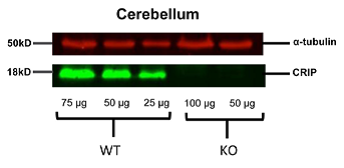Research tools
Cannabinoid Receptor-Interacting Protein 1a (CRIP1a) Knock-out Mouse
A mutant mouse line that is genetically null at the Cnrip1 locus has been developed to study the effects of loss-of-function of the regulatory protein, cannabinoid receptor-interacting protein 1a (CRIP1a). The cannabinoid receptor type 1 (CB1) is a G protein-coupled receptor (GPCR) located primarily in the central nervous system (CNS). It is activated by the endocannabinoid neurotransmitters, by plant cannabinoids, such as the compound tetrahydrocannabinol (THC), an active ingredient of the psychoactive drug cannabis, and by synthetic analogues of THC, such as dronabinol. To date, CB1 has been targeted therapeutically for seizures, nausea, depression and addiction. CRIP1a is a novel modulator of CB1 receptor-mediated signaling. It is an intracellular protein that interacts with C-terminal tail of the CB1. Proteins that interact with GPCRs in CNS provide a new venue for modulation and fine-tuning of the receptors activities. Thus far, studies in cell lines suggest that CRIP1a negatively regulates CB1 receptor signaling. Changes in CRIP1a expression have been identified in animal models of seizure disorders as well as brain tissue from human epileptic patients. Epigenetic alterations in the Cnrip1 promoter have also been identified in certain types of cancers.
The technology
CRIP1a knock-out (KO) mice are genetically modified mice, in which two exons of the Cnrip1 gene locus, encoding CRIP1a, have been replaced by a neomycin cassette, resulting in a null phenotype. These mice express no detectable CRIP1a protein or mRNA in the central nervous system, as shown in figure on the left. Since these are global KO mice, they do not express CRIP1a in any other cell in the body. The CRIP1a KO mouse model can be used to study the role of CRIP1a in physiology and behavior, and to determine its role in modulating pharmacological responses to psychoactive drugs such as cannabinoids. This mouse provides a powerful research tool for development of new drugs that have therapeutic benefits in conditions where CB1 receptor signaling is altered or off-balance, such as schizophrenia, depression and anxiety-like disorders.

Figure 1. Immunoblot of CRIP1a protein in cerebellar homogenates from wild-type (WT) and CRIP1a KO mice.
